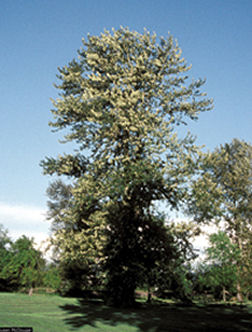- More than 2 years ago
For the first time, researchers have deciphered the DNA code of a tree. This accomplishment makes the black cottonwood, a type of poplar, the third plant species whose genome has been sequenced.

Since 2000, scientists have spelled out the long string of DNA components for rice and Arabidopsis, a plant in the mustard family that’s commonly used for genetic experiments (SN: 9/3/05, p. 157: Available to subscribers at Rice, revealed; 12/16/00, p. 388: First Plant Genome Thrills Biologists). But because both these plants are herbaceous, they are missing some genes found only in trees and other woody-stemmed plants.
Such genes might hold clues to understanding trees’ unique traits, such as their capacity to push nutrients long distances within trunks and branches and to adapt to changing conditions in one place for hundreds or thousands of years.
These traits have been tricky to examine in the lab, says tree geneticist Gerald A. Tuskan of Oak Ridge (Tenn.) National Laboratory. “These organisms are large and live a long time, so they’re difficult to study in a controlled environment,” he says.
Tuskan and scientists from 34 institutions around the world joined forces to sequence the black cottonwood (Populus trichocarpa) genome. The researchers chose this species for its relatively small genome and its importance in ecological systems and agriculture.
The team used a method called shotgun-sequence assembly. In this technique, the long strands of DNA that make up each chromosome are randomly sheared into smaller pieces. These pieces are then fed into sequencing machines, which decipher the genetic code of small sections at each piece’s ends. Tuskan explains that after doing this process over and over, breaking up the DNA in different places each time, the researchers elucidated the entire black cottonwood genome.
In a preliminary analysis published in the Sept. 15 Science, the researchers suggest that this tree has more than 45,000 genes, about twice as many as is estimated for the human genome. They also identified 93 genes associated with components that make up the tree’s cell walls.
Industrial scientists are particularly interested in two cell wall components known as cellulose and hemicellulose, says product-development manager Art Wiselogel of the Salida, Colo.–based biofuel producer BBI International. Wiselogel notes that these components can be fermented to create ethanol, a gasoline additive or alternative. Information about the black cottonwood’s genes could eventually lead to the tree’s becoming a major ethanol crop, he says.
David Neale, a tree geneticist at the University of California, Davis, adds that researchers might also use the black cottonwood genome to improve tree health, much as the human genome project has aimed to improve people’s health.
“We can better understand natural populations of forest trees and use this technology to manage forests and health. That’s where I hope this work goes,” says Neale.






